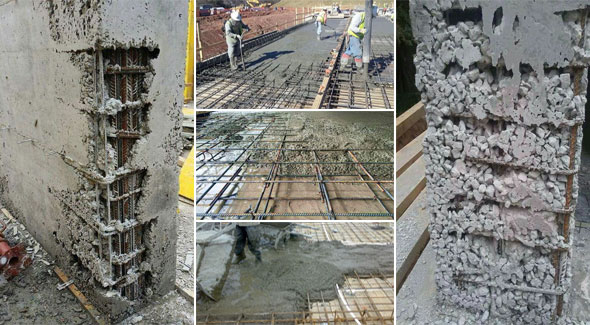Causes and remedies of concrete segregation
- Concrete Cost Estimator
- Concrete Continuous Footing
- Landscape Bidding and Estimating
- Construction Cost Estimating
- Concrete and steel cost estimation
- Construction Cost Estimate Breakdown
- Construction Estimating Worksheet
- Home Construction Cost Estimate
- Estimate Pricing Sheet
- Sheet for General Contractor
- Construction Cost Estimate
- Labor Materials Cost Estimator
- Masonry Estimating Sheet
- Sheet for Building Contractor
- Construction Schedule Bar chart
- General Cost Estimator Sheet
- General Construction Estimate
- Building and Road Estimating Sheet
- Detailed expense estimates
- Door and Window Takeoff Sheet
- General Construction Cost Estimating Sheet

Concrete segregation is defined as parting of concrete materials from each other in concrete mix. It leads to the non-uniform mix and as a result the concrete becomes porous and the strength is reduced significantly.
Normally, it is found in plastic phase of concrete. Segregation frequently happens in very lean & wet concrete. Honeycomb, sand streaks, porous layers, rock pockets etc. are the outcomes of segregation in hardened concrete.
Causes of segregation:
The major cause of segregation is the variations in the size of particles and in the specific gravity of the mix ingredients. But it can be monitored by performing the grading of concrete and by treating the concrete in exact manner.
Inclusion of greater water in dry concrete mix causes downward movement of the greater aggregates which also leads to segregation in concrete.
During the mixing of concrete at site, many times concrete workers do not mix the ingredients in a proper manner. Sometime the concrete is mixed for the lower duration or for longer duration. In both the cases, the aggregates may separate from the mix and it may be the reason of the segregation.
Normally, segregation happens when concrete constituents are not mixed in exact ratios or when precautions are not taken as the time of handling, transporting, or placing of concrete.
Segregation may occur when the concrete is dropped from the height over one mater at the place of casting, the large aggregates are detached from the mixture which results in segregation of concrete. Often, the pouring of concrete through the chute also produces the segregation issues.
Also Read: Some vital features of concrete technology
When non-graded aggregates are utilized to form concrete, the segregation in concrete may happen. If aggregates are not examined repeatedly all through the construction, it may cause inappropriate proportion of concrete and as a result segregation in concrete may occur.
Sometime unskilled worker runs machines like drum mixture, vibrator, etc. In most of the case, unskilled worker are not able to operate the machineries like drum mixture and vibrators perfectly, which may lead to the segregation of concrete. Sometimes, the poor performances of construction machineries like defective vibrator, miller, drum mixture, etc. may also result in segregation of concrete.
• Sometimes the substandard quality of shuttering materials is applied to develop the concrete members. Normally, cement slurry emerges out from the hole of formwork or broken corner/side of formwork, which cause the honeycombing of concrete. Honeycombing of concrete produces segregated concrete.
• Sometime concrete admixtures are utilized to make the workability of concrete better but the additional use of admixture may lead to the segregation in concrete.
The grades of used in the mix are substandard. The design of the mix is imperfect. The compaction of concrete is poor. Vibration of concrete is extreme.
How to reduce segregation in concrete: To control segregation, the following steps should be taken -
1. The design of the concrete mix should be perfect.
2. Added water content should not be surpassed the desired amount.
3. Handling, placing, and compaction of freshly mixed concrete should be performed in a proper manner. A proper vibration also minimizes the possibilities of segregation.
4. Concrete should not be poured from more heights.
5. Air entraining admixtures should be utilized to improve the viscosity of concrete.
6. Formwork should always be water resistant to get rid of leakages.

- Application of concrete calculator
- Roofing Calculator can streamline the roof estimating process
- House construction cost calculator
- Engineering column design excel spreadsheet
- Material Estimating Sheet with Excel
- Materials List and Cost Estimate Worksheet
- Concrete Slab Estimating Calculator Sheet
- Common types of foundations for buildings
- Online calculation of construction materials
- Estimating with Excel for the Small Contractor
- Concrete Beam Design Spreadsheet
- Virtual Construction Management app for construction
- Autodesk’s Project Skyscraper
- Reed Construction’s Reed Insight
- Manage your construction project documentation
- Costimator, the popular cost estimating software
- On Center Software for construction professionals
- Free Construction Estimating Software
- Plumbing Calc Pro
- Cost Estimate Worksheet
- HVAC Piping Quantity Takeoff Worksheet
- Construction Estimating Software Sheet
- Estimate Cost Templates
- Construction Punch List
- Construction cost estimating template consisting estimating basic
- Gantt Chart Template for Excel
- Download Civil Engineering Spreadsheets with Verification
- The Building Advisor Estimating and Budgeting Worksheet
- Spreadsheet for design of concrete bridge
- Construction Estimating Software Free








